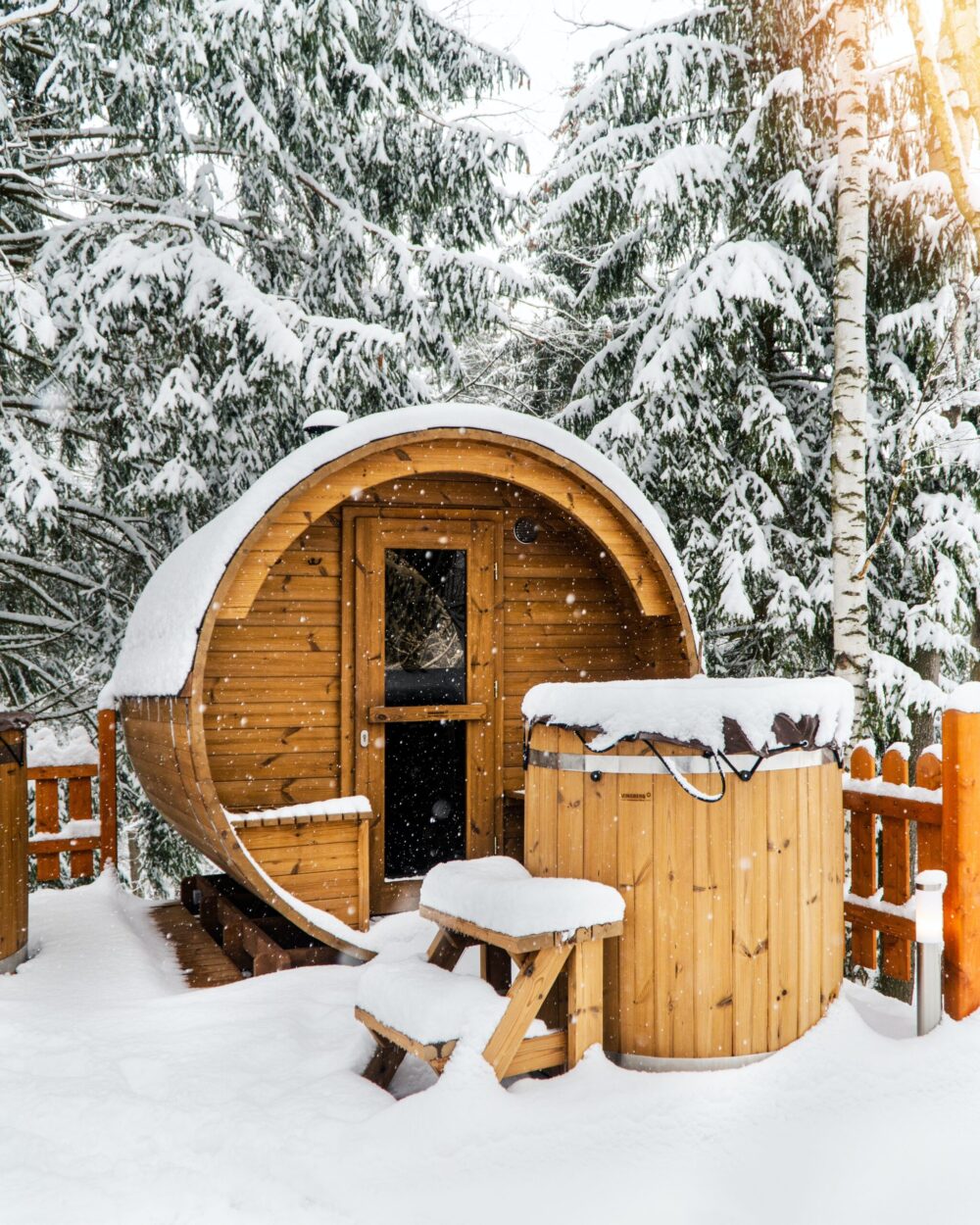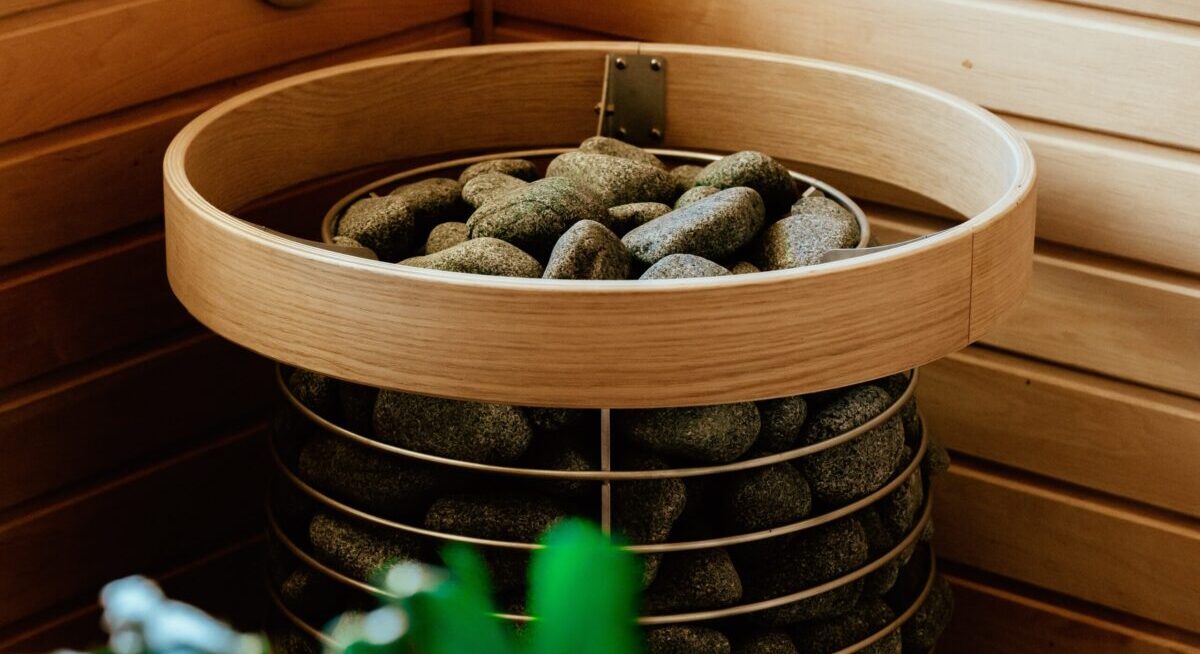Home saunas are a great way to relax and detoxify the body and mind. Thankfully, ongoing sauna maintenance and cleaning needn’t be a chore and is inexpensive compared to maintaining hot tubs. It all comes down to getting into good habits before, during, and after your bathing sessions. Follow these simple tips and tricks to keep yours in top condition so you can enjoy it for many years to come.
Everyday Sauna Maintenance Tips
To make sauna maintenance (nearly) effortless, we recommend following these simple steps before, during and after your session to keep it clean.
Cure your sauna before use
Before getting into your sauna, you should pre-heat it like you would pre-heat your oven before baking. This process is called curing your sauna. Not only does this curing process mean you get a better experience and start sweating sooner, but this dry heat also makes the environment inhospitable for bacteria and viruses.
Ideally, your sauna will be cured for an hour before you use it, but if you can’t manage that, aim for at least 30 minutes. Once your sauna is up to your desired temperature, wash your stones with water. This will also add a little humidity back into the room.
Wash before entering
Treat your home sauna like any public pool or spa, and bathe before entering. This means you’ll avoid tracking any dirt into the sauna room, and any oils that may have built up on your skin won’t be left behind on the sauna benches. When showering, we’d also recommend you avoid any harsh detergents that can seep into the wood.
Use towels or rugs
The first thing to mention here is that traditional saunas bathing is done in the nude. While that’s frowned upon in some public spas (particularly in western Europe), this is commonplace in Scandinavian saunas, and we’d recommend it at home! Not only is it liberating, it’s also more hygienic, and most swimsuits aren’t suited to such hot temperatures. In any case, taking a towel with you, whether you’re in the buff or not, is a must.
Sitting on a towel not only provides added comfort, it also acts as an absorbent layer between you and the wood. While sweating has many incredible benefits, it isn’t good for wood and can lead to discoloured benches and staining. Using a fresh towel for every session defends against that.
Use filtered or soft water.
Since hard water contains magnesium and calcium salts, it’s best to use filtered or soft water in your sauna. That’s because once any steam condenses, the salts in hard water form a limescale buildup that can become hard to clean.
Keep the room ventilated between uses
Bacteria thrive in warm, damp places. That’s why when your sauna isn’t in use, it’s a good idea to keep it well-ventilated. Open up any vents, windows, or doors after your session, and keep them open for at least a couple of hours (or more!) if possible. This allows any excess moisture to escape.
Wipe down surfaces between use
Similarly to the last point, we’d recommend wiping down surfaces you’ve been in contact with after each sauna session. The interior of a sauna is clad in porous wood with wooden benches. This wood isn’t typically treated since it needs to absorb and release moisture freely. Since untreated wood is more susceptible to wear, it’s best to use a damp cloth to wipe your surfaces down between uses to keep them clean. Again we’d recommend using filtered or soft water where possible. You don’t need to use any harsh chemicals for this. For any stubborn patches, try a mild soap or sauna-specific cleaner, or alternatively, sand down the area once it’s dry.
Use antibacterial essential oils
Most dry saunas offer hot stones that you can pour water onto, creating a light steam in the room. If you’ve got hot stones in your sauna, a great way to keep it clean and fresh is to use essential oils in your water. A handful of essential oils (such as tea tree oil, for example) have antibacterial properties. So aside from being incredible for your skin and smelling good, you’ll be helping keep your sauna in top condition.
Sauna Maintenance Checks
 Like caring for most things, sauna maintenance begins with regular check-ups. If you’re serious about keeping your sauna in top condition, inspecting the unit frequently is the best way to prevent costly or potentially time-consuming issues. Thankfully, the quickest and easiest way to do this is during your next sauna bathing session. After all, saunas make excellent environments to practice mindfulness as they promote feelings of relaxation and are usually free of distractions.
Like caring for most things, sauna maintenance begins with regular check-ups. If you’re serious about keeping your sauna in top condition, inspecting the unit frequently is the best way to prevent costly or potentially time-consuming issues. Thankfully, the quickest and easiest way to do this is during your next sauna bathing session. After all, saunas make excellent environments to practice mindfulness as they promote feelings of relaxation and are usually free of distractions.
How to perform a sauna maintenance check
While keeping your home sauna clean day-to-day isn’t challenging, it’s also worth performing a semi-regular maintenance check on some of the finer details. The frequency and depth of your inspection will depend on the type of sauna, stove, and extras you have and how often it’s used. As a minimum standard, it’s worth taking stock of your sauna at least once a year. This can, of course be done during your next bathing session. Here are some key things to look out for.
- Pay close attention to the wood, both internally and externally, if applicable. It should not be warped, stained, charred, or cracked.
- Inspect any electrical elements. Are any bulbs operational? When did a qualified electrician last inspect the wiring?
- Inspect the framing and exterior for any UV damage or deterioration. Examples of this include; loose or weathered screws, peeling varnish, or water ingress
If you notice issues needing repair, don’t delay in tending to them. Putting them off will at best, diminish your sauna experience, and at worst, potentially be hazardous.

Sauna Maintenance: Wood Fired Heaters
If you find that your sauna is taking increasingly longer to warm up, check if a new heater may be the answer. Not only can an ineffective heater spoil the experience, there may also be safety concerns if heat is escaping.
Checking your heater
Whether you’ve noticed any changes to the efficiency of your heater or not, we’d recommend checking yours at least once a year. To check it over, firstly remove all the stones and clean out your wood burning oven.
Grab a flashlight and give all the surfaces and structures a visual inspection. If you see any holes or cracks, it’s time to change your heater for a new one; a broken chamber can pose a serious safety risk.
Cleaning the heater stones
Whilst your stones are removed, it’s worth cleaning and re-stacking them. If left untouched, the stones’ structure will flatten over time. Re-stacking them will ensure there is plenty of airflow between the stones, and will result in a better steam.
To clean the stones, you can simply brush them with a soft bristled brush in some warm water.
If your stones show signs of yellowing, crumbling, or sound hollow when tapped together, it’s time to replace them.
Frequently asked questions on sauna maintenance
The wood inside your sauna needs to breathe. It swells with increased humidity, and contract as it dries. Because of that, not many products will be suitable for the interior of a sauna. Due to the heat it’s exposed to many chemical treatments/taints would become very hot to the touch, and you wouldn’t want to breathe in chemicals during your session. For all those reasons, the interior wood can be left totally untreated.
If you do treat the interior though, make sure you use a naturally formulated oil or wax designed for saunas. We recommend the Tikkurila range, which can help preserve the wood from discolouration over time, whilst still allowing the wood to breathe.
A common issue sauna goers experience is resin seeping in from their exterior walls, caused by the elevated temperatures the wood is exposed to. All our saunas are made using premium thermowood. This rigorous heating process removes the resin and protects the wood from extreme moisture/temperature changes, which resists cracking for longer and defends it from mould and rot issues.
Maintaining a home sauna is simple, if you follow good sauna hygiene before, during an after each use. When it’s kept clean between uses, a home sauna will only need an annual check over.
Do saunas have bacteria? It’s well known that bacteria thrive in warm damp places. A home sauna that’s in regular use can be kept free from lingering bacteria by following the simple practice of curing prior to each use. Because saunas use mostly dry heat at high temperatures, they are (mostly) self-cleaning. Curing is a simple technique of preparing your sauna room, by heating it up to high temperatures for at least an hour before use.
It’s still important to follow other healthy protocols in your home sauna, like sitting on a towel and keeping the room well ventilated when not in use to promote air circulation.
Is it time to replace your sauna?
There may come a time when sauna maintenance is not enough and the building is no longer functioning as it should. Perhaps its leaking heat and you’re left feeling dissatisfied after a session? Maybe you’ve just moved house and can’t live without your beloved weekly sauna rituals, or you have a growing family and need an upgrade. Whatever the reason, if you are considering replacing your sauna, please take a look at our extensive catalogue.
Neptune sauna’s have been engineered to last. From our superior thermo-wood to our range of quality heaters and robust materials, every element has been carefully selected and is covered by a 2-year warranty. You can rest assured that our premium saunas will provide decades of relaxation.
 +372 5552 6261
+372 5552 6261
